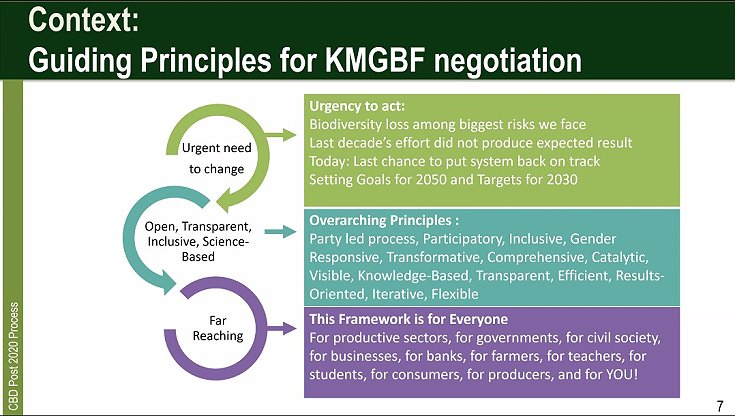 The far-reaching agreement at COP15 in December 2022 which led to the new Kunming-Montreal Global Biodiversity Framework is the successor of the Aichi targets under the Convention on Biological Diversity (CBD). The webinar on 10 March 2023 featured Mr. Basile van Havre, the Co-Chair for the Convention on Biological Diversity’s Open-Ended Working Group tasked with the development of the Kunming-Montreal Global Biodiversity Framework. The webinar was hosted hosted by the School of the Environment and the Sobey School of Business at Saint Mary’s University (Halifax, Canada) and the Community Conservation Research Network.
The far-reaching agreement at COP15 in December 2022 which led to the new Kunming-Montreal Global Biodiversity Framework is the successor of the Aichi targets under the Convention on Biological Diversity (CBD). The webinar on 10 March 2023 featured Mr. Basile van Havre, the Co-Chair for the Convention on Biological Diversity’s Open-Ended Working Group tasked with the development of the Kunming-Montreal Global Biodiversity Framework. The webinar was hosted hosted by the School of the Environment and the Sobey School of Business at Saint Mary’s University (Halifax, Canada) and the Community Conservation Research Network.
Mr. Basile van Havre has over 30 years of experience working in Canada’s Environment Department. In his talk, he shared insights how the global community negotiated an ambitious plan to halt and reverse biodiversity loss by 2030. In particular, he highlighted the learning process during the three years of negotiations that did not only involve environment ministers, but a broader segment of government representatives with a view to broaden the difficult process of building consensus.
The principles of the negotiation process are outlined in the slide below.

Following three years of negotiation, in December 2022, delegates from 196 Parties to the Convention on Biological Diversity (CBD) adopted the Kunming-Montreal Global Biodiversity Framework (GBF). Digital Sequence Information on genetic resources (DSI) was at the centre of much of the negotiations. Digital Sequence Information, or "DSI", is a policy term that refers broadly to genomic sequence data and other related digital data. This includes the details of an organism's DNA and RNA, which determine its characteristics and unique traits. The issues had first appeared in the CBD context in 2016 and then been addressed in a scientific and policy process to generate better understanding, building capacity and developing fair solutions.
The last phases were particularly intense with all parties negotiating in good spirit and owning the process. When the ministers could not to come to an agreement towards the end, the presidency intervened and put forward the Framework for adoption as a package along with
- the DSI decision,
- the Resource Mobilization Strategy, and
- the mechanisms for planning, monitoring, reporting and reviewing and the Monitoring Framework.
The overall mission is to halt and reverse biodiversity loss over the current decade until 2030.
The Global Biodiversity Framework as a whole includes 23 action oriented targets. Eight targets address reducing the threats to biodiversity, five deal with people's needs and nine cover tools and solutions including action by governments, businesses and citizens as well as reforming harmful incentives as a cost reduction measure and increasing financial resources for implementation. All this is driven by engagement, e.g. with indigenous people and particular attention to women and girls.

The entire webinar with lots of frank and insightful explanations of the dynamics of the negitiation process and its results so far combined with reflections on future steps is available here. The full text of the agreement is accessible here.
An analysis of how stakeholders assess the quality and effectiveness of marine protected areas, which are one of the major approaches to stop threat of mass extinction in the ocean, is published open access in Marine Policy. It shows lots of paper parks - so there is still hard work ahead to achieve the needed transformation of production and consumption.








